Adding the "aged" look to pictures of classic cars.
Vintage photographs that feature vehicles in them can be fascinating to pore over. If old photographs turn up of a vehicle you actual own today, then that's even better as it makes it easier to see how a car would have looked when it was comparatively new, and the context of the surroundings it once lived in.
|
|
More often than not though, old photos of a particular vehicle you own rarely turn up. Modern photos of old cars are great, but they look, well, modern! The proliferation of home computing in recent times, and the wide variety of graphical software packages (eg Photoshop, Illustrator, Paint etc) that are available, means that taking a modern photograph, and applying some "ageing" techniques to it can be quite effective, even for amateurs like me. This page contains a number of digital photographs that have been modified in various ways, to try and give a feeling of age to them. Some work better than others, but for a non-professional I think they've come out ok.
|
Choosing a photo to modify.
Any photograph can be modified, although a few minutes spent reviewing potential candidates for modification is time well spent. The aim is to produce an image that could have been taken years ago. To achieve this, firstly the car must look correct. A modern tax-disc in the window will shatter the illusion, as will incorrect tyres, modern accessories, window stickers and paint colours. Sometimes it isn't possible to disguise every modern item fitted to an old car, so care when taking the photograph to hide, or at least disguise in some way, non-period visual clues is essential. Alternatively, some doctoring with image software can successfully "remove" any offending items.
|
|
There's no point using a photograph that has an inappropriate background to it, unless you revel in spending time editing pictures. Try to use a background that could have existed at any point since the period your car was produced. Old buildings can provide a perfect backdrop, so long as they don't have satellite dishes bolted to the outside, or plastic window frames installed in them. Street scenes are particularly difficult to work with, as so many modern roads are cluttered with signs, speed humps, lines, and other paraphernalia that simply wouldn't have existed in the 1930s, 1940s or whatever period you're trying to re-create. Country lanes and stately homes can provide useful backdrops for pre-war cars. Cars of the 1950s and 1960s can actually look good with period blocks of flats, or council houses, in the background, but again finding suitable buildings unadorned with modern additions can be tricky. Personally I'm not a fan of seeing cars parked on grass at a show, to me it doesn't look very natural and I prefer to see them on roads, or other solid surfaces such as cobbles or gravel.
|
Differences between old photos and new.
Many original images scanned from old photos are on this site, and there are several details that regularly stand out that wouldn't always be found on a modern shot. These are things that could be introduced onto recently-taken pictures, to help age them a little. These include:
- Dust and other foreign objects on the camera lens
- Indifferent composition
- Over- or under-exposure
- Shake
- Early 20th Century photos are often sepia, with post-war photographs often being in black and white, with colour being more common from the late 1950s onwards
- Colours, where applicable, altering and/or fading over time, or becoming washed-out
- Creases, damp damage, foxing through poor storage
Introduction of some of these signals to a modern digital image can contribute to a period, aged look transforming what started out as a recent photo of an old vehicle. I'm no expert, and seasoned Photoshop users will have many more ideas to add to these points, but what follows are examples of pictures that can be created by anyone with a home computer, suitable image editing software (including Freeware), and a little time, with tips on how they were created, and how they could be improved upon.
|
Examples of modified vehicle photographs.
Pre-war Morris Minor.
The first photo is one I took of my own Morris at a nearby farm. Fiddling with colour balances, contrast, and saturation can go a long way in helping to age a photo. Simply making it sepia can be too obvious I think. Adding a tiny amount of Noise though can be a good idea. The background to this shot is ideal, although there are some clues that this isn't a colour photo from, say, the 1950s. There's a modern tax disc in the car's window, and the car has an age-related (but not original) registration number which tends to suggest a recent, rather than period, scene. Still, as the aim was to create a picture from the 1950s, it isn't too bad.
|
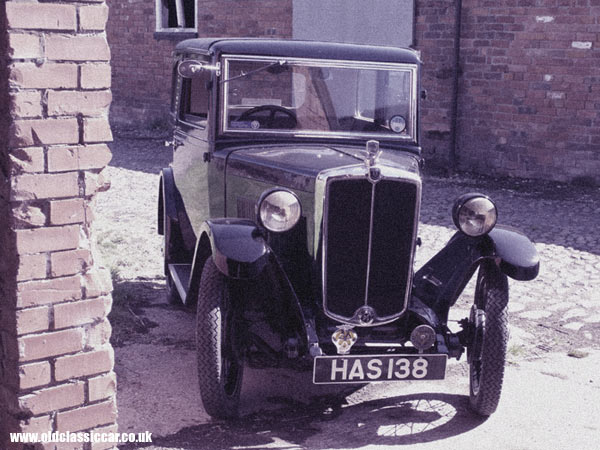
|
Various classics at an old-style garage.
The location of this next shot was a friend's old garage, built in the 1920s and still in use today. The objective here was to re-create a typical garage scene of the early 1960s. The black Austin A40 was my own car at the time, sporting appropriate badges, tax disc, and Ten Year Test windscreen transfer. Vehicles also in shot include a friend's Bedford CA camper, a late-1940s Dodge pickup, and a 1941 Chevy pickup. A grey Fergie tractor can also be seen in the background, as can an old Pratts motor spirit sign, just inside the garage. Again the colours were tweaked in various ways, resulting in a reasonably period-looking final photograph.
|

|
Austin 7 recovery.
This shot was taken a few years back when I recovered an Austin 7 from a corrugated tin building, situated within the overgrown grounds of a once-grand Victorian pile. The picture was given an under-exposed look to it, not uncommon with amateur photographers getting used to a new camera, and colour film etc, and there's nothing in this scene that couldn't have been present in a photo taken in, say, the late 1950s, Bedford van included.
|
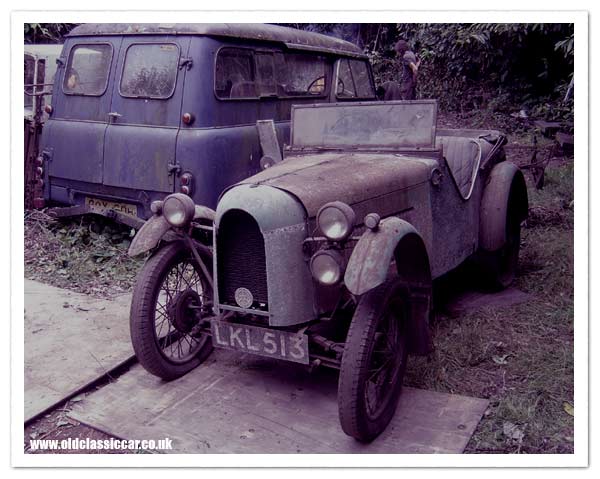
|
Picture of an old truck.
I took this one on a local roadtest in 2011. Old farm buildings are in the background, although I'm not sure that the telephone lines should be there really. I upped the contrast on this one, and turned down the saturation, to leave what I think is a reasonably successful photo.
|
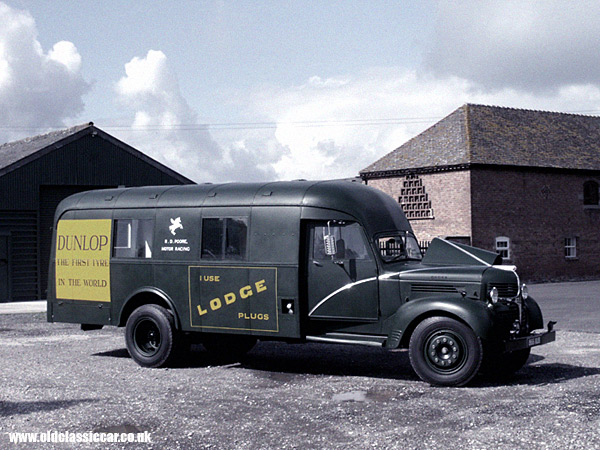
|
Car and coach in the early 1960s .... ?
Sadly neither the coach nor the house in the background are mine, although at the time the Austin Cambridge was. The brightness was turned down and the colours "washed out" a little to give this a touch of the olde-worlde about it, otherwise the original image didn't need a lot of modification.
|
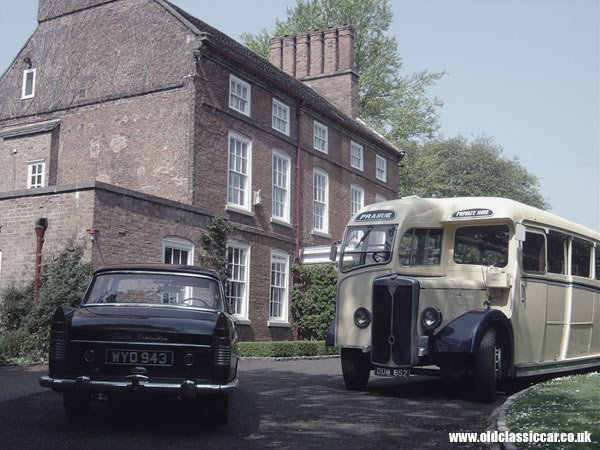
|
1950's truck and moped scene.
This was another example of getting the location right, and the vehicles exhibiting no non-period items on them, resulting in a photograph that didn't take a great deal of fettling to make into an old-ish looking shot. The correct-for-period painted number plate on the moped, and factory stop/tail light on the Chevy truck, all help to give a sense of "age" to this scene.
|
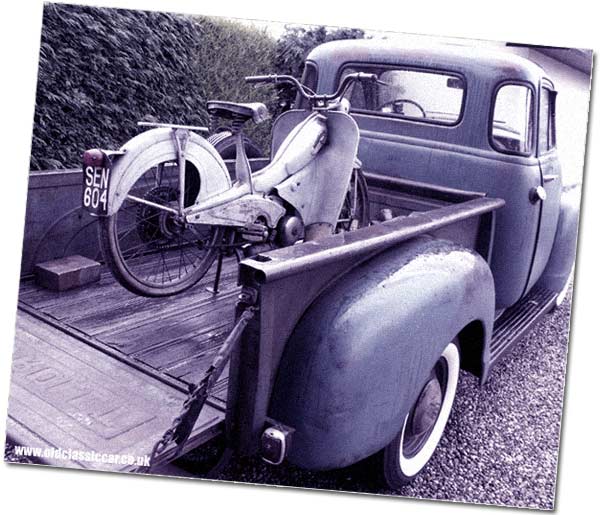
|
Paddock at a race meeting.
Ageing photographs taken at a vintage car race meeting can be frought with difficulties, largely because so many people are milling about in modern clothing (although at Goodwood matters are improved thanks to their suggested dress code). I took this photograph at a VSCC Prescott meeting at around 8am, before many of the visitors and competitors had surfaced. The timing of this shot meant that nothing from the 1950s or later is evident in this shot.
|
|
Rather than go for a simple sepia "make-over", the image was first converted to grey scale, then back to colour before some minor colour balance changes were introduced, to add a hint of sepia to it. A slight blur was introduced, as was a little noise. The main addition though was the light coming in from the lefthand side, reminiscent of when a traditional film camera is briefly opened while still in use. To get this effect, I just created a blank graphic matching the size of the photo, fading from white to black across it. The photo was overlaid as a new layer over the graphic, and the opacity of the photograph layer reduced, thus merging the two layers resulting in the effect shown below. There are probably cleverer ways of achieving the same result, but it works. All it needs now are some crinkled, moth-eaten edges to complete the effect.
|
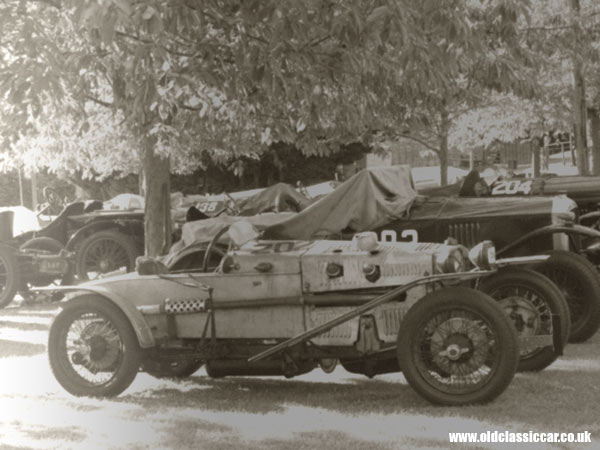
|
Garage scene.
Introducing creases and general wear 'n' tear to a photo, without necessarily going all-sepia, seems to work quite well too. This garage scene received some distressing, and being saved in a low resolution lost some of the detail that a digital camera picks up, yet probably wouldn't have featured in a quick snapshot from, say, the late 1950s.
|
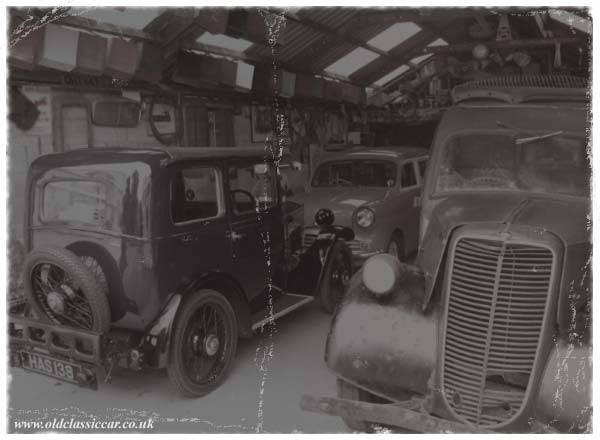
|
Austins large and small.
This next photo, aged in a similar way, is of the A40 Devon I once owned, and a pair of contemporary Austin J40 pedal cars. The creases aim to re-create the look of a photo that's been folded away in someone's wallet for years.
|
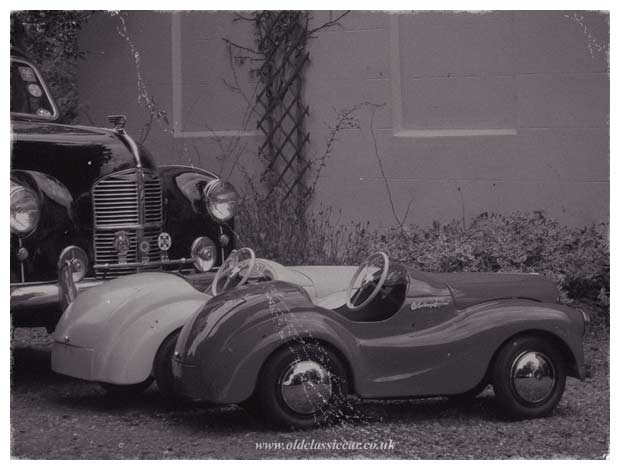
|
Mainly American.
Three vehicles of American origin are joined, in the background, by a later (1940s) Austin K2. Examples of Dodge, Chevrolet, and Willys star in this heavily-doctored photo.
|
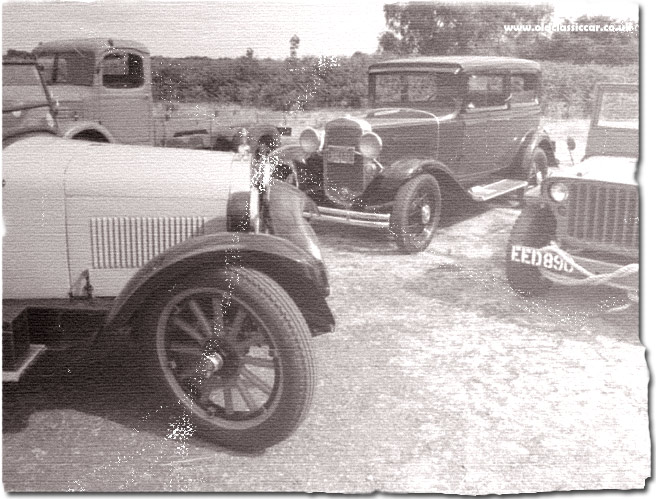
|
|
Several photographs now, all taken in a garage that was built in the late 1920s. The first re-creates fairly well a typical scene of the late 1930s/early 1940s. If it weren't for the Shell wall signs, and a grey Ferguson tractor also just in shot, it could probably pass for being a little earlier in date. Overall though I'm well pleased with this attempt. Further cropping would strengthen the pre-war feel to this view.
|
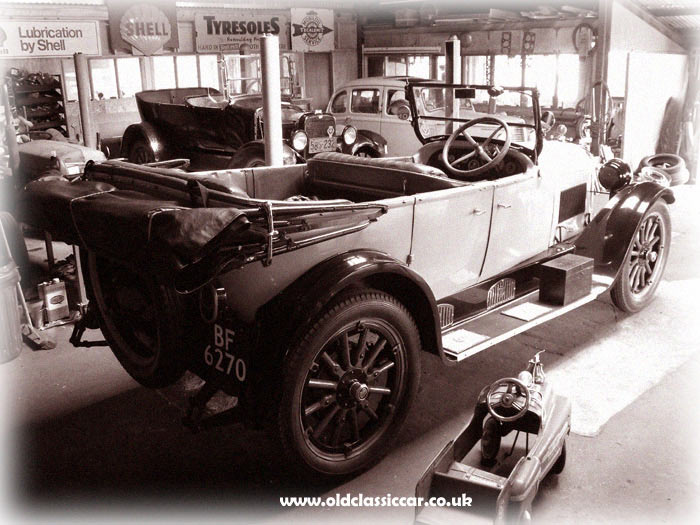
|
|
From a different position in the garage, there's little to suggest that this isn't a pre-war scene. Only the presence of a couple of British glass petrol pump globes suggest a date of the 1950s rather than the 1920s.
|
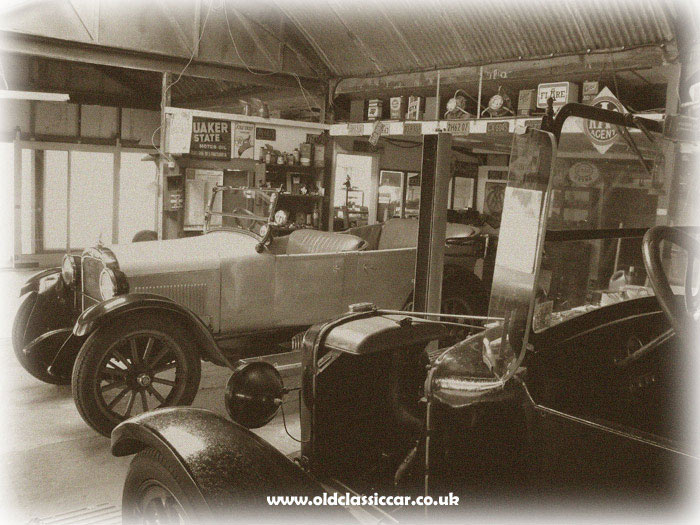
|
|
Similar to the earlier shot, again only the Shell advertising detracts from what would otherwise be a fairly convincing 1930s scene. Describe it as a re-created (just) post-war garage scene though, and it's pretty accurate.
|
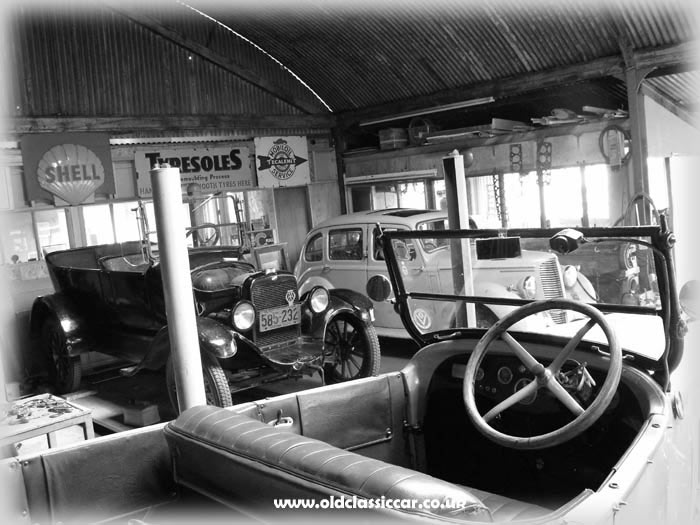
|
|
This too could be a post-war garage recorded onto photographic film, of the late 1940s or more likely mid-1950s.
|
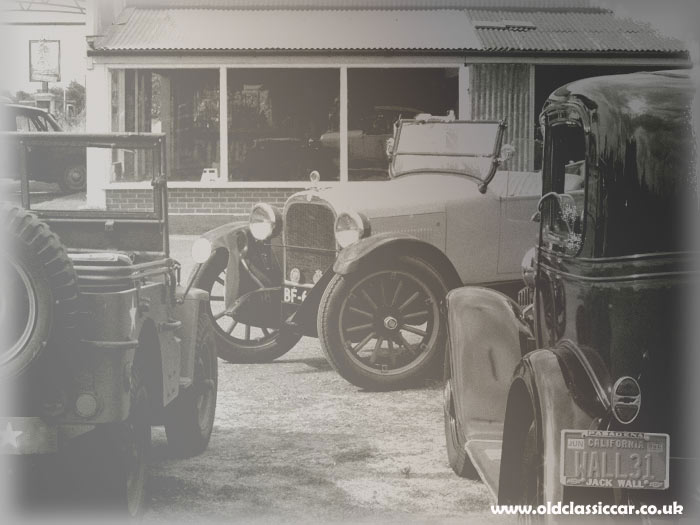
|
Returning to British vehicles.
Back to British subject matter now, and a Morris Z van of the late 1940s is shown, nosed into a garage. In the background is an example of Ford 10cwt pickup. This pickup was on sale from 1938 to 1957, so fits in perfectly well with this re-creation of a circa 1950s scene. Partially visible alongside the Ford is an in-period E494A Anglia, while to the left in the foreground is an old Esso petrol pump, and just visible inside the door, the corner of a Pratts fuel sign.
|
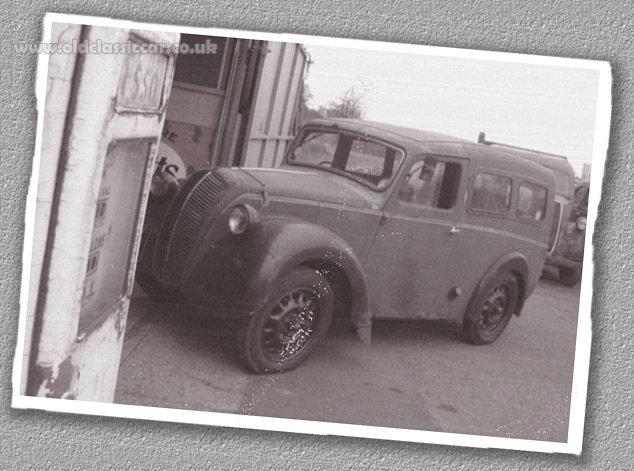
|



















